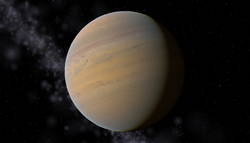Astronomy:23 Librae b
From HandWiki
Short description: Extrasolar planet in the constellation Libra
 23 Librae b (min mass ~1.59 MJ) as seen with Celestia | |
| Discovery[1][2] | |
|---|---|
| Discovered by | California and Carnegie Planet Search |
| Discovery site | W. M. Keck Observatory |
| Discovery date | November 1, 1999 |
| Doppler spectroscopy | |
| Orbital characteristics | |
| 0.81 ± 0.02 AU (121,200,000 ± 3,000,000 km) | |
| Eccentricity | 0.233 ± 0.002 |
| Orbital period | 258.19 ± 0.07 d 0.7069 y |
| astron|astron|helion}} | 2,450,331.7 ± 2.2 |
| 358.3 ± 3.7 | |
| Semi-amplitude | 49.52 ± 0.57 |
| Star | 23 Librae |
23 Librae b (23 Lib b), also known as HD 134987 b, is an extrasolar Jovian planet discovered in November 1999 orbiting the star 23 Librae. It orbits in its star's habitable zone.[1][2][3]
As of 1999, the planet was known to have at least 1.5 times Jupiter's mass. The planet orbits 23 Librae at an average distance of 0.82 AU, which is between that of Venus and the Earth in the Solar System.[4]
See also
References
- ↑ 1.0 1.1 "Astronomers discover six new planets orbiting nearby stars" (Press release). Kamuela, Hawaii: W. M. Keck Observatory. November 1, 1999. Retrieved December 19, 2017.
- ↑ 2.0 2.1 Vogt, Steven S. et al. (2000). "Six New Planets from the Keck Precision Velocity Survey". The Astrophysical Journal 536 (2): 902–914. doi:10.1086/308981. Bibcode: 2000ApJ...536..902V.
- ↑ Butler, R. P. et al. (2006). "Catalog of Nearby Exoplanets". The Astrophysical Journal 646 (1): 505–522. doi:10.1086/504701. Bibcode: 2006ApJ...646..505B.
- ↑ Jones, Hugh R. A. et al. (2010). "A long-period planet orbiting a nearby Sun-like star". Monthly Notices of the Royal Astronomical Society 403 (4): 1703–1713. doi:10.1111/j.1365-2966.2009.16232.x. Bibcode: 2010MNRAS.403.1703J.
Coordinates: ![]() 15h 13m 28s, −25° 18′ 33″
15h 13m 28s, −25° 18′ 33″
 |

